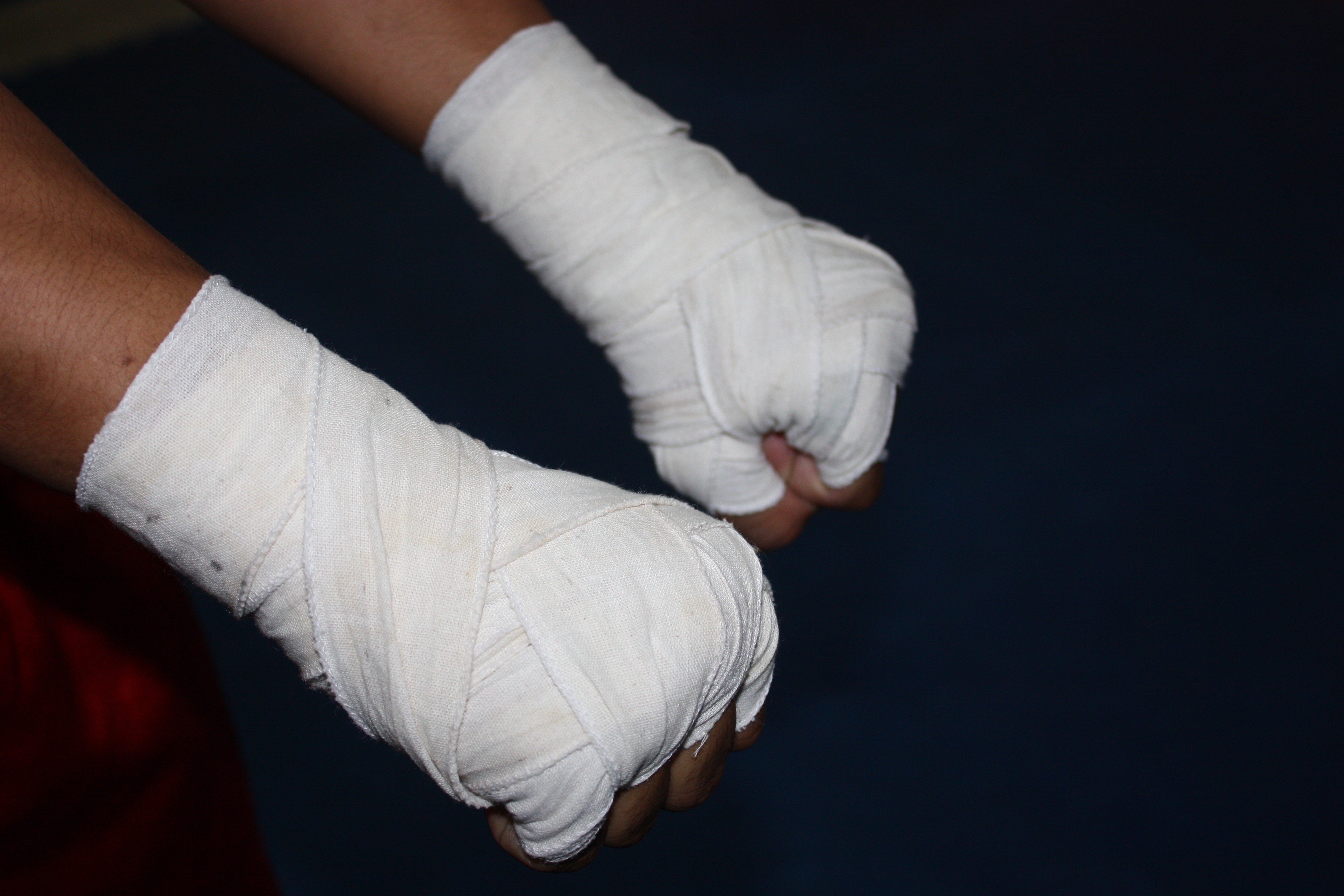
การพันหมัดคาดเชือก
การคาดเชือกเกิดขึ้นมาตั้งแต่ก่อนสมัยอยุธยาตอนกลาง โดยในปลายรัชสมัยของพระเชษฐาธิราช (พระบรมราชาที่ ๒) พระองค์ทรงระแวงว่าเจ้าพระยากลาโหมสุริยงศ์จะคิดการกบฏจึงดำรัสให้ ขุนมหามนตรี ออกไปหาตัวเจ้าพระยากลาโหมสุริยวงศ์ให้เข้าเฝ้าโดยจมื่นสรรเพชรภักดี ได้สอดหนังสือลับออกไปแจ้งแก่พระยากลาโหมว่า “พระโองการให้พาเข้ามาดูมวย บัดนี้เตรียมไว้ให้พร้อมอยู่แล้ว เมื่อเจ้าคุณจะเข้ามานั้นให้คาดเชือกเข้ามาทีเดียว” เมื่อเจ้าพระยากลาโหมสุริยวงศ์ได้รับแจ้งรหัส จึงเตรียมพร้อมและนำทหารเข้าชิงอำนาจโดยจับพระยาเชษฐาธิราชสำเร็จโทษตามประเพณีกษัตริย์ ต่อมาเหล่าขุนนางก็พร้อมกันยกเจ้าพระยากลาโหมสุริยวงศ์ขึ้นเป็นพระเจ้าประสาททองสืบไป (จัตุชัย จำปาหอม. ๒๕๕๐) ดังนั้น การคาดเชือกจึงกลายเป็นรหัสที่รู้เฉพาะผู้คิดการใหญ่ในสมัยก่อน
การคาดเชือกของนักมวยในสมัยก่อนเป็นการทำให้มือซึ่งใช้เป็นอาวุธในการต่อสู้มีความมั่นคง ไม่เกิดการบาดเจ็บและเป็นการเตรียมหมัดชกมวย ซึ่งคำว่าคาดเชือก หมายถึง การใช้ด้ายดิบที่จับเป็น “ไจ” (รวมเส้นด้าย) ต่อกันให้เป็นเส้นเชือกยาวประมาณ ๒๐ – ๒๕ เมตร ม้วนแยกเป็น ๒ กลุ่ม ความยาว ของเชือกด้ายดิบต่างกันสุดแต่ความต้องการของประเภทนักมวย หรือเกี่ยวกับความนิยมของท้องถิ่น นักมวยที่ต้องการใช้หมัดป้องปิดหน้าและให้หมัดหนักชอบใช้ด้ายยาวซึ่งมีผลเสียทำให้ชกได้ช้า ถ้าใช้ ด้ายดิบขนาดสั้น หมัดเล็กและเบาก็จะมีความว่องไว โดยไม่มีข้อบังคับว่าด้ายต้องยาวแค่ไหน นักมวยบางคนไม่คาดเชือกเลยก็สามารถขึ้นชกมวยได้
การคาดเชือกของมวยไทยในสมัยก่อนนั้นมีความแตกต่างกันไปตามท้องถิ่น โดยมวยไทยไชยามีการคาดเชือกไม่สูงเกินข้อมือมากนัก เพราะต้องการใช้ศอกรับเท้าและท่อนแขน รวมทั้งศอกกระทุ้งแทงลำตัว โดยเรียกลักษณะของการกระทำดังกล่าวว่า “ปักลูกทอย และฝานลูกบวบ” ส่วนขนาดของด้ายจะยาวหรือสั้นอยู่ที่ความถนัดของแต่ละบุคคล หากต้องการใช้หมัดปิดป้องใบหน้าก็ใช้เชือกยาวแต่จะทำให้เชื่องช้า ถ้าใช้ด้ายขนาดสั้นก็ว่องไวสามารถชกผ่านการป้องกันได้ (เขตร ศรียาภัย, ๒๕๑๗)
การพันหมัดคาดเชือกแบบมวยไทยโคราช นักมวยจะได้รับการคาดเชือกจากพี่เลี้ยงหรือครู ผู้ประสิทธิ์ประสาทวิชา ด้วยการนั่งชันหัวเข่าไว้ทั้งสองข้าง เพื่อรับแขนที่เหยียดออกไปข้างหน้าตรงข้อศอก คว่ำมือ กางนิ้วทั้งห้าออกเต็มที่ แล้วเริ่มคาดด้ายดิบตรงข้อศอกเพื่อให้กระดูกกระชับ มั่นคง ไม่เกิดการเคล็ดและซ้น ต่อจากนั้นก็พันรอบ ๆ หลังมือและข้อมือไปจนจดปลายนิ้วอย่างหลวม ๆ หันกลับมาทางข้อมืออีกครั้งแล้วจึงสอดด้ายรวบรั้งจากปลายนิ้วเข้ามาจนเลยง่ามมือให้ข้อนิ้วโผล่ถึงระยะนี้หมัดที่คาดเชือกยังคงอ่อนนุ่มคล้ายนวม เมื่อด้ายดิบยังเหลืออยู่ประมาณหนึ่งเมตร ครูผู้คาดเชือกจะบิดด้ายดิบให้เป็นเกลียวเป็นก้นหอย นักมวยจะต้องขยับนิ้วเพื่อป้องกันเหน็บชา สอดก้นหอยเข้าทีละตัวเรียงรายจนทั่วหลังหมัดซึ่งจะมีความตึงเข้าทุกที เท่านี้ยังไม่พอเพราะก้นหอยยังพลิกได้ ยังใช้ด้ายเรียกว่าหางเชือกหรือสัก สอดตรึงให้ก้นหอยไม่เอียง ตั้งตรงเป็นลักษณะหนามทุเรียน ขลิบเอาปลายแหลมออก เมื่อเริ่มจะชกจริงพี่เลี้ยงยังอมน้ำ พ่นลงไปที่หลังหมัด ด้ายดิบที่ถูกบิดตัวกลม ๆ เป็นก้นหอยเมื่อถูกน้ำเข้าจะแข็ง ฉะนั้นมวยสมัยโบราณ ถ้าหากวิชาการไม่ดีจริงหรือเครื่องรางของขลังไม่ศักดิ์สิทธิ์พอ หรืออ่อนด้วยการฝึกซ้อมจะถูกต่อยจนตาบวมปิด ด้ายดิบที่ใช้คาดหมัด ครูมวยโบราณบางท่านใช้ด้ายที่มัดตราสังศพซึ่งถูกเก็บไว้นานปี เลือดหรือเนื้อติดที่ด้ายนั้นแข็งและคมเหมือนกระดาษทรายลงอาคม ถือกันว่าเป็นของขลังหรือของอาถรรพ์อย่างหนึ่ง แต่อย่างไรก็ตามสิ่งเหล่านี้เป็นเครื่องช่วยทางด้านจิตใจและด้านกำลังใจให้เกิดความเพิ่มพูนขึ้นเท่านั้น จะฝึกฝนวิชาการมาอย่างดี ตลอดจนหลักวิชาเกิดความช่ำชองและเชี่ยวชาญแล้วเท่านั้นจึงจะเป็นอาคมที่แก่กล้าสามารถเอาชนะคู่ต่อสู้ได้อย่างชัดเจน (อำนาจ พุกศรีสุข และประจวบ นิลอาชา, ๒๕๓๐)
โดยส่วนใหญ่มวยไทยโคราช มีลักษณะเป็นมวยเตะ จึงคาดหมัดถึงข้อศอกเพื่อป้องกันการเตะ จึงนิยมใช้เชือกยาว เพราะนอกจากพันหมัดแล้ว ยังพันรอบแขนจดข้อศอกกับทั้งยังขมวดไว้กันหลุดได้ อีกด้วย
การคาดเชือกสำหรับนักมวย ได้ถูกยกเลิกไปในยุคสมัยกรุงรัตนโกสินทร์ เนื่องมาจากนายแพ เลี้ยงประเสริฐ นักมวยฝีมือดีจากอุตรดิตถ์ได้ชกนายเจียร์ พระตะบอง ครัวแขกเขมร ถึงแก่ความตาย คาสังเวียนด้วยหมัดคาดเชือก ทางคณะกรรมการหลายฝ่ายรวมทั้งทางการตำรวจได้ตกลงให้การชกมวยไทยทั่วประเทศมีการสวมนวมชก (กนกรัช สิงหพงษ์, ๒๕๓๐) ซึ่งเหตุการณ์ดังกล่าวจึงทำให้มีการสวมนวมทุกครั้งที่มีการแข่งขัน
โดยในปัจจุบันนั้นการแข่งขันชกมวยไทย จะกำหนดให้นักมวยจะต้องทำการพันมือด้วยผ้าพันมืออย่างอ่อน ยาวข้างละไม่เกิน ๖ เมตร กว้าง ๕ เซนติเมตร โดยสามารถใช้พลาสเตอร์หรือแทบกาวยาง ยาวข้างละไม่เกิน ๒.๕ เมตร กว้าง ๒.๕ เซนติเมตร ปิดทับข้อมือหรือหลังมือ โดยห้ามพันทับสันหมัดโดยเด็ดขาด และต้องได้รับการตรวจและประทับตราจากเจ้าหน้าที่เพื่อรับรองว่าเป็นไปตามข้อกำหนดแล้วจึงสวมนวมได้
(สมาคมมวยไทยสมัครเล่นแห่งประเทศไทย ในพระบรมราชูปถัมภ์, ๒๕๔๙)
สรุปท้ายบท
การพันหมัดคาดเชือกของนักมวยไทยจึงมีจุดมุ่งหมายเพื่อให้มือที่ใช้เป็นอาวุธมีความมั่นคง ไม่เกิดการบาดเจ็บและเป็นการเตรียมหมัดสำหรับการชก ซึ่งการพันหมัดคาดเชือกมีความแตกต่างกันโดยมวยไทยไชยามีการคาดเชือกไม่สูงเกินข้อมือ มวยไทยโคราชมีการคาดเชือกจนถึงบริเวณข้อศอก ส่วนมวยไทยปัจจุบันมีการพันหมัดจนถึงบริเวณข้อมือ การพันหมัดคาดเชือกจึงเป็นเอกลักษณ์ที่สำคัญอีกอย่างหนึ่งที่สามารถบ่งบอกถึงความแตกต่างของมวยไทยในแต่ละสำนักได้
ภาพที่ ๑ การคาดเชือกของมวยไทยไชยา
ที่มา : จัตุชัย จำปาหอม, ๒๕๕๐
ภาพที่ ๒ การคาดเชือกของมวยไทยโคราช
ที่มา : ชาญชัย ยมดิษฐ์และคณะ, ๒๕๕๒


ภาพที่ ๓ การพันมือก่อนการชกมวยไทย ที่มา : ต่อศักดิ์ แก้วจรัสวิไล, ๒๕๕๑รพันหการพันหมัดคาดเชือกมัดคาดเชือก
Fist Wrapping with Hemp Rope (Kaad Chueak) in Muay Thai
The practice of fist wrapping with hemp rope, known in Thai as kaad chueak, dates back to the period before the mid-Ayutthaya era. Toward the end of King Chetthathirat’s reign (King Borommaracha II), the monarch harbored suspicions that Chaophraya Kalahom Suriyawongse was planning a rebellion. As a result, he ordered Khun Mahamontri to summon Suriyawongse to the royal court. However, Jamuen Sanphet Phakdi smuggled a secret message to Chaophraya Kalahom, stating: “His Majesty invites you to observe a boxing match. Everything is already prepared. When you come, be sure to wear the kaad chueak.” Recognizing the coded message, Suriyawongse prepared an armed force, seized power, and executed King Chetthathirat according to royal custom. The nobles subsequently declared him King Prasat Thong (Jattuchai Champahom, 2007). Thus, the phrase “kaad chueak” came to signify a coded message recognized only by conspirators or those plotting major actions in ancient times.
In historical Muay Thai, the purpose of kaad chueak was to stabilize the fists—Muay Thai’s primary weapon—prevent injury, and prepare the boxer’s hands for combat. The term refers to binding raw cotton yarn, spun into a long rope of approximately 20–25 meters, divided into two bundles. The length and thickness of the rope varied based on regional traditions and the fighter’s preferences. Fighters seeking powerful punches and defensive coverage favored longer wraps, albeit at the cost of reduced speed. Conversely, those preferring agility used shorter wraps, which allowed for faster striking but provided less protection. There was no universal regulation regarding rope length; in fact, some fighters competed without any hand wrapping at all.
The method of wrapping differed by regional fighting styles. In Muay Chaiya, the rope was not wrapped much higher than the wrist, to facilitate the use of the elbow to block kicks and to deliver thrusting elbow strikes to the body—a technique known as Pak Look Toi and Faan Look Buap. The choice of rope length was based on personal preference; long rope offered more protection but slowed movement, while short rope allowed faster attacks that could penetrate the opponent’s guard (Khet Sriyapai, 1974).
In Muay Korat, the wrapping process was typically performed by the boxer’s trainer or mentor. The fighter would kneel, arms extended, palms facing down and fingers spread. Wrapping began at the elbow to secure the joint and prevent sprains. The rope was then loosely wound around the back of the hand and wrist to the fingertips, and back toward the wrist. The rope was gathered from the fingertips inward, leaving the knuckles exposed. At this stage, the hands still felt soft, similar to gloved fists. With approximately one meter of rope remaining, the trainer would twist the rope into spirals or “snail shells,” which were applied to the back of the hand, creating increasing tension. These spirals were further secured with what was called the tail rope (hang chueak or sak), to prevent the spirals from slipping—resulting in a surface resembling durian thorns. The sharp ends were trimmed. Before the fight began, trainers often sprayed water onto the wrapped fists. The dampened rope would then harden, forming a tough surface. As such, Muay Thai in ancient times was brutal—fighters without strong technique, effective protective charms, or rigorous training could suffer severe injuries, including swollen-shut eyes. In some traditions, the rope used came from funerary bindings (trasaang), believed to carry supernatural power. These ropes, after being stored for years and infused with incantations, were thought to be razor-sharp and imbued with protective magic. Nonetheless, such beliefs primarily served to bolster mental and emotional strength. Ultimately, only those with extensive training and mastery of the art could truly claim efficacy in battle (Amnat Phuksrisuk & Prachuap Nilacha, 1987).
Since Muay Korat focused primarily on powerful kicking techniques, fighters would often wrap their arms all the way up to the elbow to protect against incoming kicks. Long ropes
The practice of kaad chueak was abolished during the Rattanakosin era. The turning point came when Nai Liang Prasert, a skilled boxer from Uttaradit, fatally injured Nai Jear, a Cambodian fighter from Battambang, during a bout with hemp-wrapped fists. This incident led multiple governing bodies and law enforcement agencies to mandate the use of boxing gloves in all Muay Thai competitions nationwide (Kanorach Singhapong, 1987).
Today, in modern Muay Thai competitions, fighters are required to wrap their hands with soft gauze—no longer than 6 meters per hand and 5 centimeters in width. Adhesive tape may be used (no longer than 2.5 meters and no wider than 2.5 centimeters), to reinforce the wrist or back of the hand. However, wrapping over the knuckles is strictly prohibited. The wraps must be inspected and officially stamped by a licensed official before gloves can be worn (Amateur Muaythai Association of Thailand under Royal Patronage, 2006).
Conclusion
The primary purpose of kaad chueak or fist wrapping in Muay Thai was to stabilize the fists, prevent injuries, and prepare the hands for combat. Techniques and wrapping styles varied across Muay Thai schools: Muay Chaiya typically wrapped no higher than the wrist, while Muay Korat extended the wrap up to the elbow. In modern Muay Thai, hand wraps are restricted to the wrist area using regulated gauze and tape. Therefore, kaad chueak serves as an important cultural marker that distinguishes between Muay Thai traditions and reflects the unique identity of each regional fighting style.
